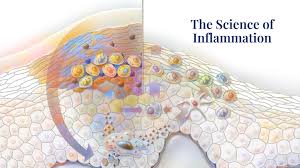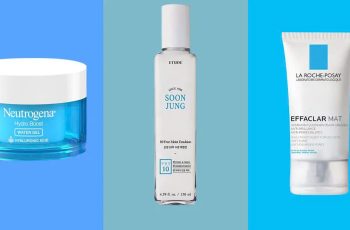The Science of Skin Inflammation
Inflammation occurs when one of the pathways discussed below is activated. It is a complicated process because all of the pathways influence each other on, causing a domino effect. This is a brief discussion of the science of what causes skin inflammation.
This material is adapted from Anti-inflammatory Ingredients in Ch. 38 of Baumann’s Cosmetic Dermatology (McGraw Hill 2022)
Eicosanoids in Skin Inflammation
Phospholipids found in the cell membrane are hydrolyzed by phospholipase A2 (PLA2), releasing free arachidonic acid (AA). This fatty acid is the primary precursor of eicosanoids. Eicosanoids are mediators of inflammation. Types of eicosanoids are:
Prostaglandins
Thromboxanes
Leukotrienes
Prostacyclins
There are two different pathways in the synthesis of eicosanoids from AA:
Cyclooxygenase (COX) pathway: Prostaglandins, thromboxanes, and prostacyclins
are synthesized via the cyclooxygenase pathway. Two cyclooxygenases have been identified: COX-1 and COX-2. COX-1 is ubiquitous. COX- 2 is induced in response to inflammatory stimuli.
Lipoxygenase pathway: Lipoxygenase enzymes can act on AA to form hydroperoxyeicosatetraenoic (HPETE) acids (5-HPETE, 12-HPETE, and 15-HPETE). HPETEs are then rapidly reduced to hydroxylated derivatives (HETEs), LTs, or lipoxins.
Cytokines in Skin Inflammation
Cytokines are signals that cells produce. Cytokines that play a role in inflammation are produced by various cell types, but the most important sources are the immune cells: macrophages and monocytes found in the inflammatory areas. See Table “Inflammation-Associated Cytokines” so see which cytokines play a major role in inflammation.
As seen in the table, numerous types of cytokines play a role in skin inflammation. Two of these orchestrate inflammation: interleukin-1 (IL-1) and tumor necrosis factor-α (TNF-α). These two cytokines induce the production of lipid mediators, proteases, and free radicals. The cytokines interferon-γ (INF-γ) and granulocyte colony-stimulating factor (G-CSF) amplify the inflammatory response by increasing the production of IL-1 and TNF-α by macrophages.
Chemokines
Chemokines (chemotactic cytokines) are small proteins that direct the movement of circulating white blood cells to areas of inflamed skin.
Mast Cells in Skin Inflammation
Mast cells are activated to release histamine by binding the immunoglobulin E (IgE) or by physical stimuli (e.g., heat, cold, and sunlight), macrophage-derived cytokines, bacterial toxins, venoms, trauma, and the presence of allergens.
Skin Allergies
When a mast cell armed with IgE antibodies is re-exposed to an allergen, multiple responses occur, leading eventually to the release of various potent mediators responsible for the clinical expression of immediate inflammatory-hypersensitivity reactions that is commonly called “an allergic reaction” or “hives”. In the first step of this sequence, antigens bind to the IgE antibodies previously attached to the mast cells. The bridging of IgE molecules with the underlying IgE-Fc receptors activates signal transduction pathways that will translate into three outcomes:
1) Degranulation, with the secretion of preformed mediators like vasoactive amines (e.g., histamine), neutral proteases (e.g., chymase, tryptase, hydrolase), and proteoglycans (e.g., heparin, chondroitin sulfate);
2) De novo synthesis of pro-inflammatory lipid mediators (i.e., LTs C4, D4, and B4, and PG D2)
3) Synthesis and secretion of cytokines (i.e., TNF-α, IL-1, IL-3, IL-4, IL-5, IL-6, and GM-CSF), as well as chemokines, such as macrophage inflammatory protein (MIP)-1α and MIP-1β.
Histamine and Skin Inflammation
Histamine is stored in mast cells. When mast cells degranulate, they release histamine. When histamine binds the H1-receptor, cytokines and lysosomal enzymes from macrophages are released and cell-adhesion molecules are expressed which influences the activity of basophils, eosinophils, and fibroblasts. Both the H1- and H3-receptors play a role in the itching felt during a skin allergy.
Free Radicals and Skin Inflammation
White blood cells release oxygen-derived free radicals after exposure to challenges such as microbes, chemokines, or immune complexes. Free radicals cause the expression of chemokines, cytokines, and endothelial leukocyte adhesion molecules, amplifying the inflammatory cascade and making inflammation worse. High levels of free radical cause cell damage triggering more inflammation and destruction of the extracellular matrix and loss of hyaluronic acid, collagen, and elastin.
Kinins in Skin Inflammation
The kinin-kallikrein system is a network of circulating proteins that affect inflammation, blood pressure control, coagulation, and pain. Kinins [bradykinin (BK) and kallidin (KD)] are polypeptides produced from kininogen and broken down by kininases. They are rapidly generated after tissue injury and they affect the inflammatory process by increasing arachidonic acid release and increasing eicosanoid production and activating nuclear factor-κB (NF-κB), further contributing to the inflammatory response. Kinins also induce pain.
DQH Knowledge drop: In your 20s, your skin cell turnover decreases. (Cell turnover is a key component in keeping your skin youthful.) You know what else slows down? Your collagen production. Starting in your 20s, collagen decreases by about 1 percent per year. Should you want to prevent fine lines and wrinkles, start by eliminating behaviors that contribute to premature aging. “If it’s bad for you, it’s bad for your skin,” says dermatologist Michel Somenek.
“Cigarette smoking reduces blood flow to the skin and causes premature wrinkling and a dull skin texture. Making the repeated pursed motion to inhale can also cause smoker’s lines. Alcohol and recreational drugs are toxins for the skin that damage its cellular structure and DNA,” Somenek tells us. “The faster you eliminate vices while you are young, the better chance your skin and body have to recuperate.” Also, adopting an anti-aging routine in your 20s is key. After all, the best offense is a good defense. We spoke to Somenek and experts Joshua Ross and Audrey Kunin to find out more.
Keep reading for the best anti-aging products for your 20s, according to skincare professionals.
Sunscreen
“We all know that the sun is the number one cause of skin aging and starting the prevention in your 20s is very important,” Ross says. “The majority of your sun damage won’t start to appear until you’re in your 30s, so don’t wait until you see it surface or you’ll be behind the curve. Stay ahead of it with a good-quality zinc-based sunscreen worn daily.”
Farmacy Green Defense Daily Mineral Sunscreen
An invisible sunscreen with SPF 30, plus botanical extracts meant to protect skin with tons of antioxidants. Bonus: It’s clean and fine to use under makeup.
Bareminerals Complexion Rescue™ Tinted Moisturizer Broad Spectrum SPF 30
Although we recommend you use your SPF and moisturizer separately, we also understand moments when you don’t have time or energy for that extra step. For those times, this bareMinerals moisturizer is a great thing to have on hand.
Vitamin C Serum
“A great introduction to anti-aging is to start with a vitamin C serum in your morning skincare routine,” Ross says. “It’s a powerful antioxidant that will neutralize free radicals and brighten the skin.” He adds that it’s a great way to counteract the effects of the sun’s harmful rays, which, as previously mentioned, are among the biggest causes of premature aging.
Drunk Elephant C-Firma™ Vitamin C Day Serum
The Drunk Elephant C-Firma is a lightweight serum that promises to give skin a glow by combining the brightening powers of vitamin C with ferulic acid, l-ascorbic acid, and vitamin E. The included sodium hyaluronate is meant to replace hydration loss, so you shouldn’t have to deal with any irritation.
Sunday Riley C.E.O. Rapid Flash Brightening Serum
This potent serum is jam-packed with vitamin C (15 percent, to be exact), which means it’s a potential superstar at both brightening skin and dousing it in antioxidants.
Peptides
Using peptides on your skin has many benefits, says Somenek. “The skin barrier is what defends the body against pollution, UV rays, bacteria, and toxins. It can be damaged by several everyday factors. Using topical peptides aids in building a stronger barrier,” he says. “Peptides comprise elastic fibers, which are a type of protein. These fibers help to make skin appear taut and firm. Peptides can also help repair damaged skin, relieve inflammation, and even out skin tone. Some peptides can kill acne-causing bacteria that is common in 20-somethings.”
Kunin agrees, saying, “Peptides are an excellent entry point for supporting collagen.” She recommends looking for face and eye treatments that contain these collagen-boosting powerhouses.
Charlotte Tilbury Magic Eye Rescue Cream
This Charlotte Tilbury super-emollient eye cream has a base of coconut oil and shea butter (read: it’s incredibly hydrating). Botanicals plus peptides are meant to help reduce dark circles and boost collagen, respectively.
This creamy moisturizer serves up potent collagen-boosting peptides and pycnogenol, and antioxidant-rich vitamin C. “Instead of sitting on top of the skin, peptides penetrate the outer layer so they go deep. The ‘signals’ they send tell the cells to produce elastin and collagen, which are needed for youthful-looking skin,” explains Somenek.
At-Home Peel Pads
Remember that skin cell turnover fiasco we talked about earlier? One way to help support it is by exfoliating. “Exfoliation is important to help keep skin fresh and luminous,” Kunin says. She recommends using at-home peel pads as an easy and effective way to exfoliate.
“The goal in your 20s is to fight the slowing pace of cell turnover. It is wise to use products that gently exfoliate, yet still remove oil and other impurities. Products that have Alpha Hydroxy Acids (AHA) or Beta Hydroxy Acids (BHA) are a good choice.”
According to Somenek, you should only exfoliate two to three times a week. “People of all ages are guilty of over-exfoliating and that can be too much of a good thing,” he says.
Dermadoctor Kakadu C Intensive Vitamin C Peel Pad
A few swipes of this Derma Doctor powerful peel pad promise to leave your skin glowing and smooth, thanks to the seven (yes, seven) types of chemical exfoliants, including AHA and BHA. It also contains vitamin C via Kakadu plum extract for added brightening and antioxidant protection.
KEY INGREDIENTS Kakadu plum extract is sourced from the Kakadu plum, a fruit grown in northern Australia. It contains vitamin C, which restores the skin’s natural barrier, increases collagen production, and soothes irritation.
Dr. Dennis Gross Skincare Alpha Beta® Universal Daily Peel Pads
These are the gold standard of peel pads, with a cult following and over 900 five-star reviews on Sephora. They’re easy to use and contain a blend of anti-aging exfoliating acids.
Emollient Night Cream
“In your 20s, you need to start upping the hydration in your skincare routine. You may have been cautious of over-moisturizing because of acne in your teens, but as you enter your 20s, your skin transitions and becomes drier,” Ross says. “I recommend an emollient night cream added into your evening skincare regimen.”
“Twenty-somethings need to make sure that they are not using creams that will clog their pores and cause excess oil production,” says Somenek. Opt for non-comedogenic products.
Cerave Skin Renewing Night Cream
One great choice is the CeraVe Skin Renewing Night Cream, which is a non-comedogenic night cream that leaves skin soft and glowy. It combines the moisturizing powers of ceramides and hyaluronic acid.
RoC Retinol Correxion Max Hydration Creme
“The best night cream ingredients contain retinol, benzoyl peroxide, and/or salicylic acid or hyaluronic acid. The goal is to moisturize, yet remove excess oil,” says Somenek. This Roc Retinol Correxion cream fits the bill as it contains both hyaluronic acid and retinol so it promises to moisturize while also being non-comedogenic.



